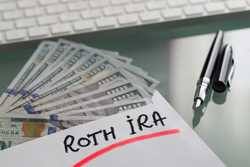What Is a Backdoor Roth IRA? Benefits, Limits, Conversion

Our evaluations and opinions are not influenced by our advertising relationships, but we may earn a commission from our partners’ links. This content is created by TIME Stamped, under TIME’s direction and produced in accordance with TIME’s editorial guidelines and overseen by TIME’s editorial staff. Learn more about it.
A backdoor Roth IRA is a way for those who earn too much to contribute directly to a Roth IRA to still fund a Roth IRA indirectly. The backdoor Roth generally starts with an after-tax contribution to a traditional IRA, followed by a conversion to a Roth IRA.
First, you make an after-tax contribution to a traditional IRA, which is followed by a conversion to a Roth IRA. This can be a complicated transaction with a lot of moving parts, so you will want to be sure to understand all aspects of the backdoor Roth IRA before moving forward. A financial advisor with experience in Roth conversions can help you understand and navigate the complexities and pitfalls of this complicated transaction.
The main benefit of a backdoor Roth IRA contribution is the ability to contribute to a Roth IRA even if your income is too high to contribute directly.
Making a backdoor Roth contribution means that the money converted to the Roth IRA will not be subject to required minimum distributions (RMDs) after the account holder turns 73. Having money in a Roth IRA also provides tax diversification for the account holder once they reach retirement. If the five-year rule requirements are met and you are at least 59½, there are no 10% early withdrawal penalties and withdrawals will be tax-free.
With the enactment of the SECURE Act that went into effect on January 1, 2020, the rules for inherited IRAs for most non-spousal beneficiaries changed. Prior to this, those inheriting an IRA could stretch it out over their own lifetimes in most cases. While RMDs are required for IRAs inherited prior to these new rules, the ability to stretch the RMD payments out over a longer period has served to minimize the tax hit for many beneficiaries.
The SECURE Act changed the rules for what are called “non-eligible designated beneficiaries.” This includes many non-spousal beneficiaries. The new rules require that these beneficiaries must withdraw all of the money within 10 years from an IRA inherited beginning in 2020 or later (the 10-year rule).
In the case of an inherited Roth IRA, the 10-year rule still applies. However, the withdrawals will be tax-free as long as the original account holder satisfied the five-year rule on the account prior to their death. This can allow the beneficiaries to keep more of their inheritance.
The backdoor Roth technique is mainly for those investors who want to be able to contribute to a Roth IRA, but who earn too much in a given tax year to do so. To benefit from a backdoor Roth IRA, you need to be able to pay any extra taxes that might be triggered by the conversion. This is true of any type of Roth conversion, or for any type of taxable withdrawal from a traditional IRA. If you don’t have the cash on hand to pay taxes on the conversion, it may not be a good strategy.
There are several steps involved in doing a backdoor Roth IRA.
Typically the contributions to start the backdoor Roth IRA process are made on an after-tax basis to a traditional IRA account.
There may or may not be any taxes when the conversion from the traditional IRA to a Roth IRA are made. This will be governed by the pro-rata rule. This rule says that if you have amounts in a traditional IRA that consists of money contributed on a pre-tax basis, the amount converted is taxed based on the ratio of after-tax contributions to pre-tax contributions and earnings in total across all traditional IRA accounts you may hold. Note that beyond just regular traditional IRA accounts, the calculation would also include amounts in a SEP-IRA or SIMPLE IRA account.
If you do not have any other money in a traditional IRA, your backdoor Roth IRA might be tax free. If you contribute $7,000 after-tax to a traditional IRA and do the conversion right away, the conversion will be tax-free assuming that your contribution to the traditional IRA did not have any earnings in between the time of your contribution and the time when the conversion occurred.
Using the same $7,000 after-tax contribution, if you wait for a period of time and there are earnings inside of the traditional IRA, then the conversion will be taxed based on the ratio of the amount pertaining to the tax-free contributions and the earnings portion of the conversion.
Let’s say that the earnings in the account are $250 by the time you do the conversion. The total amount of the conversion was $7,250. The amount subject to taxes would be 3.4% of the amount converted. This is calculated as $250 divided by $7,250.
Let’s look at a different situation using the same $7,000 after-tax contribution to the traditional IRA. In the case of our hypothetical person, she has $100,000 in total inside of traditional IRA accounts counting the $7,000 contribution. Of this $100,000, $20,000 is the result of after-tax contributions and the rest consists of money contributed on a pre-tax basis plus earnings inside of the accounts. Of any money she converts 80% will be subject to taxes.
The IRA contribution limits for a particular year govern the amount that can be contributed to a traditional IRA to start the backdoor Roth process. The IRA contribution limits for 2024 and 2025 are $7,000, with an additional $1,000 catch-up contribution for those who are 50 or over.
The other limit that pertains to backdoor Roth IRAs are the income limitations on the ability to contribute directly to a Roth IRA account. This is the main reason that people do a backdoor Roth IRA. For 2024 and 2025, the following are the income limits on the ability to contribute directly to a Roth IRA.
| Filing status | 2024 modified AGI limits | 2025 modified AGI limits | Contribution limits |
|---|---|---|---|
Married filing jointly and qualifying widow(er) | Less than $230,000 | Less than $236,000 | No contribution limits |
$230,000 to $240,000 | $236,000 to $246,000 | Reduced, phased out | |
$240,000 or more | $246,000 or more | No contributions allowed | |
Single, head of household, or married filing separately (if you did not live with your spouse at any point during the year) | Less than $146,000 | Less than $150,000 | No contribution limits |
$146,000 to $161,000 | $150,000 to $165,000 | Reduced, phased out | |
$161,000 or more | $165,000 or more | No contributions allowed | |
Married filing separately (if you lived with your spouse at any point during the year) | Less than $10,000 | Less than $10,000 | Reduced |
$10,000 or more | $10,000 or more | No contributions allowed |
Before doing a backdoor Roth IRA, be sure to check on the impact of the pro-rata rule discussed above. This will govern the level of taxes due on the conversion to the Roth IRA account. Note that the pro-rata rules apply for any type of Roth IRA conversion, whether or not it is part of a backdoor Roth IRA.
In considering a backdoor Roth IRA, be sure to take your current year tax situation into account. How will any taxes incurred on the conversion impact your overall taxes for the year?
If your goal is to fund a Roth account at the highest level possible, you might consider contributing to a Roth 401(k) or a Roth option in another type of workplace retirement plan, depending on what is offered by your employer’s retirement plan. There are no income limitations on contributions to a Roth 401(k) or similar Roth option, and under the new SECURE 2.0 rules, matching contributions will also be allowed to be made into your Roth account as well.
Another option, if your employer’s plan offers it, is the mega backdoor Roth. Under this option you would make after-tax contributions into your employer’s 401(k) plan. For 2024 the limit for these after-tax contributions is $46,000. This is over and above the annual employee contribution limit of $23,000, with another $7,500 in catch-up contributions for those who are 50 or over.
Depending upon the rules of the plan, you may be able to do an in-service conversion to a Roth 401(k) option. Some plans allow in-service withdrawals, in which case you would do a rollover and conversion to a Roth IRA account at an outside custodian. Otherwise you would need to wait until you separate from the employer and do a rollover and conversion to an outside Roth IRA.
Taxes here would generally be on the amount of gains tied to the money in the after-tax account upon conversion. You will want to verify this with a tax professional prior to doing the conversion to be sure of your tax liability so there are no negative surprises.
Tax penalties on a Roth IRA generally occur when you try to make a withdrawal from the account if you are under age 59½ and if the five-year rule has not been satisfied.
There is a “clock” on each Roth IRA conversion regarding the five-year rule. Be aware of this before trying to withdraw any of the funds tied to a backdoor Roth IRA conversion. Note that there is a separate five-year rule clock on each Roth conversion.
If you have a hardship situation there are some exceptions to the normal qualified withdrawal rules that might cause penalties and/or any taxes due to be waived. Be sure to check with a knowledgeable tax advisor if this situation applies to you.
A backdoor Roth IRA may be right for you if you’d like to be able to contribute to a Roth IRA but you earn too much money to do so for the tax year in which you would like to contribute.
A Roth IRA can be a solid way to avoid required minimum distributions in the future, add tax diversification to your retirement accounts and be able to minimize taxes for non-spousal heirs who might inherit the Roth IRA.
Consider working with a financial advisor knowledgeable in backdoor Roth IRAs. Platforms such as WiserAdvisor will match you to an expert in your area based on your financial needs.
Find the right financial advisor with WiserAdvisor
Find the right financial advisor with WiserAdvisor
In the past there were concerns that the backdoor Roth IRA process might violate an IRS rule called the step transaction doctrine. Under this rule, if the sum of multiple steps in a transaction are illegal then the totality of the actions to achieve the desired result is illegal.
In the case of a backdoor Roth IRA, since the intent is to skirt the income limitations on making a contribution to a Roth IRA there were concerns that the whole backdoor Roth IRA process might be against the rules. This could have conceivably resulted in penalties and other measures from the IRS.
In 2018 the IRS indicated that the use of a backdoor Roth IRA conversion process does not violate the step transaction doctrine.
The short answer is no, you only pay taxes once on a backdoor Roth IRA. Taxes may be due when the conversion from the traditional IRA to a Roth IRA is done to an extent dictated by the pro-rata rule as it applies to your conversion.
As long as the five-year rule and other requirements are met there will be no taxes on money withdrawn from the Roth IRA.
Although there has been talk of eliminating the backdoor Roth in recent years, this option is still allowed in 2024. We cannot predict what will happen in the future, of course.
The backdoor Roth is considered a legal way to get around the income limits in place regarding the ability to contribute directly to a Roth IRA. Contrary to what some may believe, the backdoor Roth IRA is not considered a tax dodge by the IRS. If you do have any concerns about the legalities of this technique or any other type of financial transaction we strongly suggest you contact a knowledgeable tax or legal advisor.
The information presented here is created by TIME Stamped and overseen by TIME editorial staff. To learn more, see our About Us page.




